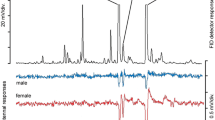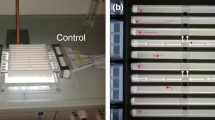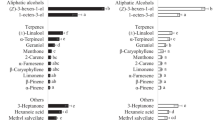Abstract
The beech leaf-mining weevil, Orchestes fagi, is a common pest of European beech, Fagus sylvatica, and has recently become established in Nova Scotia, Canada where it similarly infests American beech, F. grandifolia. We collected volatile organic compounds (VOCs) emitted by F. grandifolia leaves at five developmental stages over one growing season and simultaneously analyzed them for volatile emissions and O. fagi antennal response using gas chromatography-electroantennographic detection (GC-EAD). Volatile profiles changed significantly throughout the growing season, shifting from primarily β-caryophyllene, methyl jasmonate, and simple monoterpene emissions to dominance of the bicyclic monoterpene sabinene during maturity. Two VOCs dominant during bud burst, (R)-(+)-limonene and geranyl-p-cymene, may be of biological relevance due to the highly specific oviposition period of O. fagi at this stage though antennal responses were inconclusive. Senescence showed a decrease in blend complexity with an increase in (Z)-3-hexenyl acetate and (Z)-3-hexen-1-ol as well as a resurgence of α-terpinene and geranyl-p-cymene. We present a novel electroantennal preparation for O. fagi. Antennae of both male and female O. fagi responded to the majority of detectable peaks for host volatiles presented via GC-EAD. Females displayed greater overall sensitivities and less specificity to host volatiles and it is hypothesized that this translates to more generalist olfaction than males. It is clear that olfactory cues are important physiologically though their implications on behaviour are still unknown. The results presented in this study provide a baseline and tools on which to connect the complex and highly time-specific phenology of both F. grandifolia and the destructive pest O. fagi through which olfactory-based lures can be investigated for monitoring systems.



Similar content being viewed by others
References
Alford DV (1995). A color atlas of pests of ornamental trees, shrubs and flowers. Halsted Press, New York
Aslam NA (1961) An assessment of some internal characters in the higher classification of the Curculionidae S.L. (Coleoptera). Trans R Ent Soc Lond 113:417–480
Bale JS (1979) The occurrence of an adult reproductive diapause in the univoltine life cycle of the beech leaf mining weevil, Rhynchaenus fagi L. Int J Invert Rep 1:57–66
Bale JS (1981) Seasonal distribution and migratory behaviour of the beech leaf mining weevil, Rhynchaenus fagi L. Ecol Entomol 6:109–118
Bale JS (1984) Bud burst and success of the beech weevil, Rhynchaenus fagi: feeding and oviposition. Ecol Entomol 9:139–148
Bale JS, Luff ML (1978) The food plants and feeding preference of the beech leaf mining weevil, Rhynchaenus fagi L. Ecol Entomol 3:245–249
Bartelt RJ (1999) Weevils. In: Hardie J, Minks AK (eds) Pheromones of non-lepidopteran insects associated with agricultural plants. CABI, Wallingford, pp 91–112
Beaudet M, Messier C (2008) Beech regeneration of seed and root sucker origin: a comparison of morphology, growth, survival, and response to defoliation. Forest Ecol Manag 255:3659–3666
Cao QJ, Yu J, Ran YL, Chi DF (2015) Effects of plant volatiles on electrophysiological and behavioural responses of Cryptorhynchus lapathi. Ent Exp App 156:105–116
Cheong JJ, Choi YD (2003) Methyl jasmonate as a vital substance in plants. Trends Genet 19:409–413
Davis C, Meyer T (2004) Field guide to tree diseases of Ontario. Natural Resources Canada, Canadian Forest Service, Great Lakes Forestry Centre, Sault Ste. Marie, ON. NODA/NFP Tech Rep TR-46:92–93
Dickens JC, Prestwich GD, Sun WC (1991) Behavioral and neurosensory responses of the boll weevil, Anthonomus grandis Boh. (Coleoptera: Curculionidae), to fluorinated analogs of aldehyde components of its pheromone. J Chem Ecol 17:1007–1020
Dieter VA (1964) Beitrag zur epidemiologie und biologie des Buchenspringrüßlers Rhynchaenus (Orchestes) fagi L. an Obstgewächsen. Anz Schädl 37:161–163
Dindorf T, Kuhn U, Ganzeveld L, Schebeske G, Ciccioli P, Holzke C, Kölbe R, Seufert G, Kesselmeier J (2006) Significant light and temperature dependent monoterpenes emissions from European beech (Fagus sylvatica L.) and their potential impact on the European volatile organic compound budget. J Geosphy Res 111:1–15
Ehrlich J (1934) The beech bark disease. A Nectria disease of Fagus, following Cryptoccus fagi (Baer.). Can J Res 10:593–692
Engelberth J, Alborn HT, Schmelz EA, Tumlinson JH (2004) Airborne signals prime plants against insect herbivore attack. Proc Natl Acad Sci 101:1781–1785
Fall R, Karl T, Hansel A, Jordan A, Lindinger W (1999) Volatile organic compounds emitted after leaf-wounding: on-line analysis by proton-transfer-reaction mass spectrometry. J Geol Res 104:15963–15974
Farmartin (2014) American beech foliage during autumn in the woodlands along the West Branch Shabakunk Creek in Ewing, New Jersey. In: Wikimedia Commons. https://commons.wikimedia.org/w/index.php?curid=36975055#filehistory. Accessed 8 September 2020
Finch S, Collier RH (2000) Host-plant selection by insects – a theory based on ‘appropriate/inappropriate landings’ by pest insects of cruciferous plants. Entomol Exp Appl 96:91–102
Ghelardini C, Galeotti N, Mannelli LDC, Mazzanti G, Bartolini A (2001) Local anaesthetic activity of β-caryophyllene. Il Farmaco 56:387–389
Goodwin JTL, Pawlowski SPP, Mayo PD, Silk PJ, Sweeney JD, Hillier NK (2020) Influence of trap colour, type, deployment height, and a host volatile on monitoring Orchestes fagi (Coleoptera: Curculionidae), in Nova Scotia, Canada. Can Entomol 152:98–109
Gossner MM, Weisser WW, Gershenzon J, Unsicker SB (2014) Insect attraction to herbivore-induced beech volatiles under different forest management regimes. Oecologia 176:569–580
Grimm R (1973) Food and energy turnover of phytophagous insects in beech forests. I Oecologia 11:187–262
Grimm R (1990) Flugverhalten und wirtdfindung des Buchenspringrüßlers Rhynchaenus fagi L. (Col.: Curculionidae) beim einflug in den buchenwald nach der überwinterung. Mitt Dtsch Ges Allg Angew Ent 7:395–404
Gupta AD, Bansal VK, Babu V, Maithil N (2013) Chemistry, antioxidant and antimicrobial potential of nutmeg (Myristica fragrans Houtt). J Gen Eng Biotech 11:25–31
Hillier NK, Kavanagh RMB (2015) Differential octopaminergic modulation of olfactory receptor neuron responses to sex pheromones in Heliothis virescens. PLoS One 10:e0143179
Hillier NK, Kleineidam C, Vickers NJ (2006) Physiology and glomerular projections of olfactory receptor neurons on the antennae of female Heliothis virescens (Lepidoptera: Noctuidae) responsive to behaviourally relevant odors. J Comp Physiol A 192:199–219
Houston DR (1994) Major new tree disease epidemics: beech bark disease. Annu Rev Phytopathol 32:75–87
Houston DR, O’Brien, JT (1983). Beech bark disease. Forest insect & disease leaflet 75, U.S. Department of Agriculture Forest Service
Houston DR, Parker EJ, Lonsdale D (1979) Beech bark disease: patterns of spread and development of the initiating agent Cryptococcus fagisuga. Can J For Res 9:336–344
Javadipour Z, Balouchi H, Dehnavi MM, Yadavi A (2019) Roles of methyl jasmonate in improving growth and yield of two varieties of bread wheat (Triticum aestivum) under different irrigation regimes. Agr Water Manage 222:336–345
Jha S, Harcombe PA, Fulton MR, Elsik IS (2004) Potential causes of decline in American beech (Fagus grandifolia Ehrh.) in weir woods, Texas. Tex J Sci 56:285–298
Jirovetz L, Buchbauer G, Ngassoum MB, Geissler M (2002) Aroma compound analysis of Piper nigrum and Piper guineese essential oils from Cameroon using solid-phase microextraction-gas chromatography, solid-phase microextraction-gas chromatography-mass spectrometry and olfactometry. J Chromatogr A 976:265–275
Kaissling KE (1974) Sensory transduction in insect olfactory receptors. In: Jaenicke L (ed) Biochemistry of sensory functions. Springer, Heidelberg, pp 243–273
Keesey IW, Barrett BA, Lin CH, Lerch RN (2012) Electroantennographic responses of the small chestnut weevil Curculio sayi (Coleoptera: Curculionidae) to volatile organic compounds identified from chestnut reproductive plant tissue. Environ Entomol 41:933–940
Kendra PE, Montgomery WS, Niogret J, Deyrup MA, Guillén L, Epsky ND (2012) Xyleborus glabratus, X. affinis, and X. ferrugineus (Coleoptera: Curculionidae: Scolytinae): Electorantennogram responses to host-based attractants and temporal patterns in host-seeking flight. Environ Entomol 41:1597–1605
König G, Brunda M, Puxbaum H, Hewitt CN, Duckham SC (1995) Relative contribution of oxygenated hydrocarbons to the total biogenic VOC emissions of selected mid-European agricultural and natural plant species. Atmos Environ 29:861–874
Leskey TC, Wright SE, Anger W, Chouinard G, Cormier D, Pichette A, Zhang A (2009) Electroantennogram technique for Conotrachelus nenuphar (Coleoptera: Curculionidae). Environ Entomol 38:870–878
Luo H, He W, Li D, Bao Y, Riaz A, Xiao Y, Song J, Liu C (2020) Effect of methyl jasmonate on carotenoids biosynthesis in germinated maize kernels. Food Chem 307:125525
MacKay CA, Sweeney JD, Hillier NK (2015) Olfactory receptor neuron responses of a longhorned beetle, Tetropium fuscum (Fabr.) (Coleoptera: Cerambycidae), to pheromone, host, and non-host volatiles. J Insect Physiol 83:65–73
Macnish AJ, Jiang CZ, Negre-Zakharov F, Reid MS (2010) Physiological and molecular changes during opening and senescence of Nicotiana mutabilis flowers. Plant Sci 179:267–272
Mihál I, Cicák A, Tsakov H (2014) Selected biotic vectors transmitting beech bark necrotic disease in central and South-Eastern Europe. Folia Oecologica 41:62–74
Moise ERD, Forbes GB, Morrison A, Sweeney JD, Hillier NK, John RC (2015) Evidence for a substantial host-use bottleneck following the invasion of an exotic, polyphagous weevil. Ecol Entomol 40:796–804
Morin RS, Liebhold AM, Tobin PC, Gottschalk KW, Luzader E (2007) Spread of beech bark disease in the eastern United States and its relationship to the regional forest composition. Can J For Res 37:726–736
Morrison A, Sweeney J, Hughes C, Johns R (2017) Hitching a ride: firewood as a potential pathway for range expansion of an exotic beech leaf-mining weevil, Orchestes fagi (Coleoptera: Curculionidae). Can Entomol 149:129–137
Moukhtar S, Bessagnet B, Rouil L, Simon V (2005) Monoterpene emissions from beech (Fagus sylvatica) in a French forest and impact on secondary pollutants formation at regional scale. Atmos Environ 39:3535–3547
Mozaffar A, Schoon N, Bachy A, Digrado A, Heinesch B, Aubinet M, Fauconnier ML, Delaplace P, du Jardin P, Amelynck C (2018) Biogenic volatile organic compound emissions from senescent maize leaves and a comparison with other leaf developmental stages. Atmos Environ 176:71–81
Mutis A, Parra L, Manosalva L, Palma R, Candia O, Lizama M, Pardo F, Perich F, Quiroz A (2010) Electroantennographic and behavioral responses of adults of raspberry weevil Aegorhinus superciliosus (Coleoptera: Curculionidae) to odors released from conspecific females. Environ Entomol 39:127–1282
Nielsen O (1966) Studies on the fauna of beech foliage 1. Contribution to the biology of the early stages of the beech weevil (Rhynchaenus (Orchestes) fagi L.), (Coleoptera: Curculionidae). Natura Jutl 12:162–181
Nielsen O (1968) Studies on the fauna of beech foliage 2. Observations on the mortality and mortality factors of the beech weevil [Rhynchaenus (Orchestes) fagi L.] (Coleoptera: Curculionidae. Natura Jutlandica 14:1011–1021
Nielsen O (1970) Observations on the hibernation of the beech weevil (Rhynchaenus fagi L.) in Denmark. Ent Scand 1:223–226
Nielsen BO (1974a) A record of insect activity on beech stems (Fagus sylvatica L.) by means of arboreal photoecloectors. Ent Meddr 42:1–18
Nielsen BO (1974b) A study on the weevil fauna (Curculionidae) in a Danish beech forest. Ent Medd 42:169–188
Nielsen BO, Ejlersen A (1977) The distribution pattern of herbivory in a beech canopy. Ecol Entomol 2:293–299
Nielsen BO (1978) Food resource partition in the beech leaf‐feeding guild. Ecol Entomol 3:193–201
Obando-Ulloa JM, Nicolai B, Lammertyn J, Bueso MC, Monforte AJ, Fernández-Trujillo JP (2009) Aroma volatiles associated with the senescence of climacteric or non-climacteric melon fruit. Postharvest Biol Technol 52:146–155
Ormeño E, Baldy V, Ballini C, Fernandez C (2008) Production and diversity of volatile terpenes from plants on calcareous and siliceous soils: effect on soil nutrients. J Chem Ecol 34:1219–1229
Pajares JA, Allue M, Hernandez E (1990) Rhynchaenus fagi L., un curcliónido minador foliar del haya. Bol San Veg Plaga 16:411–418
Pawlowski SP (2014). Chemical ecology of the invasive beech leaf mining weevil (Orchestes fagi L.) in Nova Scotia, Canada. B.Sc. Honours Thesis, Acadia University, April 2014
Pawlowski, SP (2017). Comparative analyses on the phenology, electrophysiology, and chemistry of the beech leaf-mining weevil (Orchestes fagi L.) and its novel host American beech (Fagus grandifolia Ehrh.). Master’s thesis. Acadia University
Phillipson J, Thompson DJ (1983) Phenology and intensity of phyllophage attack on Fagus sylvatica in Wytham woods, Oxford. Ecol Entomol 8:315–330
Pichersky E, Gershenzon J (2002) The formation and function of plant volatiles: perfumes for pollinator attraction and defense. Curr Opin Plant Biol 5:237–243
Pullin AS (1985) A simple life table study based on development and mortality in the beech leaf mining weevil Rhynchaenus fagi L. J Biol Educ 19:152–156
R Core Team (2015). R: a language and environment for statistical computing. R Foundation for Statistical Computing, Vienna. Available from: http://www.R-project.org/
Ranger CM, Reding ME, Schultz PB, Oliver JB (2012) Ambrosia beetle (Coleoptera: Curculionidae) responses to volatile emissions associated with ethanol-injected Magnolia virginiana. Environ Entomol 41:636–647
Sabulal B, Dan M, John A, Kurup R, Pradeep NS, Valsamma RK, George V (2006) Caryophyllene-rich rhizome oil of Zingiber nimmonii from South India: chemical characterization of antimicrobial activity. Phytochemistry 67:2469–2473
Sangster A, Singh S, Sooksom R (2010). Climate and soil considerations: resource kit for Nova Scotia farmers. Nova Scotia Department of Agriculture. https://novascotia.ca/thinkfarm/documents/fsheets/02-climate-soil-considerations.pdf. Accessed 4 December 2019
Schuh G, Heiden AC, Hoofman T, Khal J, Rockel P, Rudolph J, Wildt J (1997) Emissions of volatile organic compounds from sunflower and beech: dependence on temperature and light intensity. J Atmos Chem 27:219–318
Silk PJ, Mayo PD, LeClair G, Brophy M, Pawlowski S, MacKay C, Hillier NK, Hughes C, Sweeney JD (2017) Semiochemical attractants for the beech leaf-mining weevil, Orchestes fagi. Ent Exp App 164:102–112
Strausfeld NJ (2012) Arthropod brains: evolution, functional elegance, and historical significance. Harvard University Press, Cambridge, Massachusetts
Sweeney J, Anderson RS, Webster RP, Neville R (2012) First records of Orchestes fagi (L.) (Coleoptera: Curculionidae: Curculioninae) in North America, with a checklist of the north American Ramphini. Coleopt Bull 66:297–304
Sweeney J, Hughes C, Zhang H, Hillier NK, Morrison A, Johns R (2020) Impact of the invasive beech leaf-mining weevil, Orchestes fagi, on American beech in Nova Scotia, Canada. Front For Global Change 3:1–11
Tavallali V, Karimi S (2019) Methyl jasmonate enhances salt tolerance of root stalks by regulating endogenous phytohormones, antioxidant activity and gas exchange. J Plant Physiol 234-235:98–105
Tholl D, Boland W, Hansel A, Loreto F, Röse USR, Schnitzler JP (2006) Practical approaches to plant volatile analysis. Plant J 45:540–560
Tollsten L, Müller PM (1996) Volatile organic compounds emitted from beech leaves. Phytochemistry 43:759–762
Toshova TB, Velchev DI, Subchev MA, Tóth M, Vuts J, Pickett JA, Dewhirst SY (2010) Electrophysiological responses and field attraction of the grey corn weevil, Tanymecus (Episomecus) dilaticollis Gyllenhall (Coleoptera: Curculionidae) to synthetic plant volatiles. Chemoecology 20:199–206
Tubbs CH, Houston DR (1990). American beech (Fagus grandifolia Ehrh.). In: Silvics of North America (Burns RM, Honkala BH: technical coordinators). USDA Forest Service agriculture handbook 654, USDA Forest Service, Washington, DC, USA, pp 654-667. Available from: https://www.srs.fs.usda.gov/pubs/misc/ag_654/volume_2/vol2_table_of_contents.htm. Accessed 8 Sept 2020
van Tol RWHM, Visser JH (2002) Olfactory antennal responses of the vine weevil Otiorhynchus sulcatus to plant volatiles. Ent Exp App 102:49–64
Wang G, Tian L, Aziz N, Broun P, Dai X, He J, King A, Zhao PX, Dixon RA (2008) Terpene biosynthesis in glandular trichomes of hops. Plant Physiol 148:1254–1266
Watt AD, McFarlane AM (1992) Does damage-mediated intergenerational conflict occur in the beech leaf-mining weevil? Oikos 63:171–174
Woodcock BA, Vanbergen AJ (2008) Parasitism of the beech leaf-miner weevil in a woodland: patch size, edge effects and parasitoid species identity. Insect Conserv Diver 1:180–188
Acknowledgements
We would like to thank Drs. Peter Silk and Peter Mayo for providing chemical inventory and to Natural Resources Canada, SERG-International, Atlantic Canada Opportunities Agency – Atlantic Innovation Fund, and Acadia University for funding. All experiments reported here comply with the laws of Canada.
Availability of Data and Material
Data are not openly accessible.
Code Availability
Not applicable.
Funding
Funding for this research was provided by grants and contracts from Natural Resources Canada, SERG-International grant, Atlantic Canada Opportunities Agency Atlantic Innovation Fund (197853), and Acadia University.
Author information
Authors and Affiliations
Contributions
All authors participated in designing research. SP conducted experiments, analyzed results, and wrote manuscript. NKH and JS edited manuscript. All authors read and approved manuscript.
Corresponding author
Ethics declarations
Conflicts of Interest/Competing Interests
Nothing to disclose.
Ethics Approval
No ethics approval required, this research did not involve studies with human participants or animals.
Consent to Participate
No consent to report.
Consent for Publication
No consent to report.
Rights and permissions
About this article
Cite this article
Pawlowski, S.P., Sweeney, J.D. & Hillier, N.K. Electrophysiological Responses of the Beech Leaf-Mining Weevil, Orchestes fagi, to Seasonally-Variant Volatile Organic Compounds Emitted by American Beech, Fagus grandifolia. J Chem Ecol 46, 935–946 (2020). https://doi.org/10.1007/s10886-020-01216-z
Received:
Revised:
Accepted:
Published:
Issue Date:
DOI: https://doi.org/10.1007/s10886-020-01216-z




